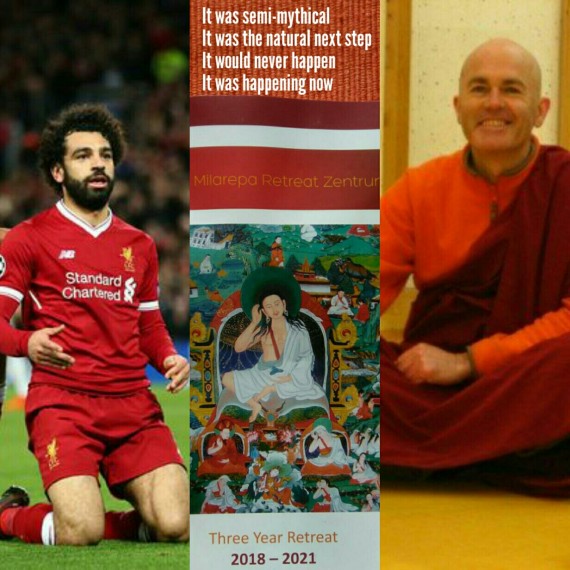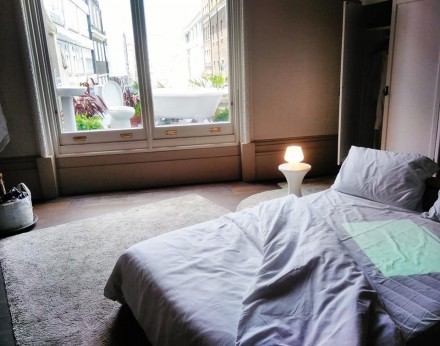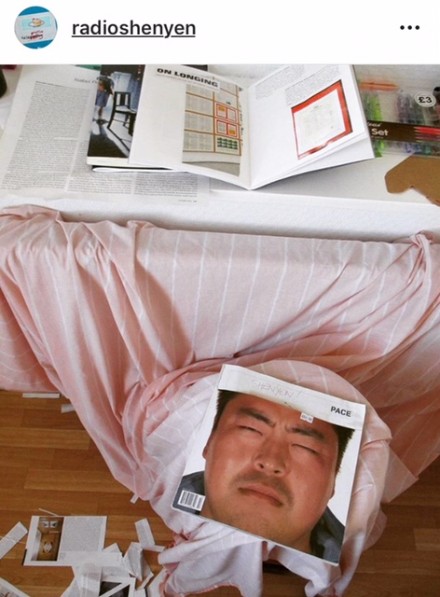
Questions to a monk
IN TEN DAYS TIME, Tenzin Shenyen will embark on a 3-year Tibetan Buddhist retreat in Germany that “begins a cycle of practices to stabilise, concentrate and open the mind through more meditative practices that… include practices aimed at transcending one’s deeply ingrained delusional tendency to see oneself and the world as ordinary.”
Q: It’s been 3 years since you gave a talk at Service Design Conference in Stockholm. It was wonderful to see the whole conference meditating with you. It palpably changed the energy in the room. I especially appreciated your advice for design professionals to ‘Just Say No!’ more often. I think that advice is more important than ever. Can you expand on that a bit?
A: As I said in one of my posts about the approaching retreat, I think human beings are machines for producing works of art, and that the best works of art are nameless and invisible. Saying “no” to what is visible and which already has a name is one way into that space. I also re-read Castaneda’s Journey To Ixtlan recently and was touched by how deeply I still resonated with it. There’s a lot of ‘no’ saying in it, from ‘erasing personal history’ to ‘losing self-importance’, to ‘becoming inaccessible’ and ‘disrupting the routines of life’. The genuinely ‘new’ comes out of nowhere – and I mean absolutely nowhere, a brutally total nowhere- but we are too eager to be ‘somewhere’, no matter how shabby and derivative that ‘somewhere’ might be.
I hope at least one designer out there reads this and decides to say ‘no’ to the whole works — until reappearing twelve years later with something with no name and no identity that the whole world needs.

“Saying goodbye to house sits and temporary rooms, to the forest and one-litre bottle-showers at twilight, to the over-exposure of homelessness. Saying hello to deep seclusion and practice. The worlds we inhabit are neither visible nor invisible, but secretive, coded, nuanced and blessed. Saying goodbye also to Facebook, and hoping something more nuanced, respectful and soulful has taken its place by the time I come out again. I’ll meet you there, I’m sure.”
Q: What impact does your Buddhist practice have on your daily life today? How does Buddhism work as a practical guideline for daily decision making? How can this shape a layman’s decision-making to live an ethical life as an ‘ordinary’ person?
A: My daily life is perfumed by Buddhism. It allows me to see everything I do as a kind of prayer. For example, right now I’m watching the world cup. It’s football and I love it, it needs no justification. My unconscious is working tremendously hard preparing for the retreat, so Shenyen is balancing that by just relaxing. I don’t need to justify it. Justifications are for people who are organising pogroms, or asset-stripping entire national infrastructures, etc. not for people who are … content just being nobody, nowhere, just talking with The Invisibles, just owning one pair of shoes … or just watching Argentina’s slalom into the knockout stage while reading Jorge Valdano reflecting on the military dictatorship of the 1970’s, along with his plea to stop treating football as a science; it all turns it all into a kind of dream yoga. And dream yoga is part of the path to Buddhahood. You cannot live an ethical life without nurturing your imagination.
Elaine Scarry’s talk, Beauty as a call to justice, will explain that in detail. I re-posted it on my youtube channel. Ultimately no-one can tell you how to live, they can only seduce you into living in a specific way. Ethics thus emerges from Eros, from loving relationships — with yourself, people around you, your own karmic history, and the culture around you and the times you have been born into.
Q: You spoke once about the importance of combining Buddhist practice with your own ‘culture’ or your natural place in contemporary society as a western monk. Will you still have space for that kind of ‘personal cultural research/ observation’ on your 3-year retreat? Can you watch football when you are there?! Can you read Artforum? Can you write your blog, radioshenyen?
A: Football? Probably not! But in between the meditation blocks, that will usually last about 6-8 weeks per topic, we are encouraged to relax, maybe even listen to a little music. And I will have my Artforum scrapbooks with me. Enough for one exhibition a week I think! But I don’t see too much separation between the centuries-old tantric stuff and my personal interests. Doing the retreat in all its traditional structure is also a part of my ‘personal cultural research’.
Q: How much meditation do you recommend to a layperson or beginner? Is frequency important for practice? Are there other types of activities such as physical work (making things, cleaning, gardening, etc.) that are also seen as part of Buddhist practice? In Asia, meditation isn’t seen as something that ‘ordinary people’ do. Lay people often ask the monks to meditate and pray on their behalf.
A: Meditation is extremely over-emphasised in contemporary Western presentations of Buddhism. Ethics, study, art, service, offering, confession, purification, prayer, chanting, and vows, among other things, are all sidelined, or dismissed as ‘obvious’, ‘old-fashioned’, ‘embarrassing’ or ‘peripheral’. But Buddhism only really comes alive when you take on board it’s entire culture, it’s ‘world’ while being willing to do the work of engaging that world with your own. Thus, my love of contemporary art is inseparable from my study of Madhyamaka and tantric meditations. My best moments of mindfulness occur when on alms round. You can’t just meditate in a vacuum, in a fog of mundane activity and thinking.
But nevertheless, it is part of the path.
I would recommend a very short commitment — 10 minutes a day is fine — to being quiet, still, disciplined and visionary on one’s cushion. But instead of wanting to meditate I would suggest that people simply pray to be able to meditate, and then relax. Thinking about what other people need — the immediate needs of the people around you right now, at home or on the train platform — is so much more powerful than some half-hearted meditation practice.
Genuine meditation comes out of uncontrived faith. Faith arises out of joy and ethics. Ethics from art and empathetic disciplined imagination.
Q: We need to manage negative attachments to the idea of future, such as fear or sadness or anxiety, as these feelings arise, to avoid shutting down altogether. Is hope also an attachment?
A: Attachment is one of those words that are easy to misconstrue. In Buddhism, liking something isn’t an expression of attachment; wanting something good to continue, or to happen if it hasn’t yet happened, isn’t attachment. Attachment is defined as a state where ‘you are willing to do something bad in order for something to continue (or begin)’. So ‘hope’ in itself isn’t attachment. Love isn’t attachment, not even fierce love. Whereas cowardice would be.
Q: What is your favourite festival or holiday? What practices in your life have changed significantly since becoming ordained?
A: I like New Year’s celebrations. Awareness of time cycles is a lovely thing and transcends specific religions and worldviews. And the atom bomb memorial day in Hiroshima is also high on my list of ‘things which make the heart beat faster’ – if that’s what you mean by ‘festival’.
Ordination, by providing an absolutely fundamental challenge to my sense of identity, in both challenging (demanding, humbling) and transformative (blessed) ways, has helped me to explore more deeply the teachings on non-self as a meditative state.
Q: How important is it to be altruistic?
A: It is impossible to become a Buddha without practising altruism. And never mind Buddhahood, it is impossible to keep enjoying positive samsaric rebirths without practising altruism. All art comes from altruism.
Links:
– For those interested in reading more about the 3-year retreat there are 5 posts on Shenyen’s blog, radioshenyen that talk about it in more detail. https://radioshenyen.blogspot.com/
– Shenyen on Youtube: https://www.youtube.com/channel/UCKf_RRjzHsJ5a_LtWltGubA
– Images from Shenyen’s Instagram: @radioshenyen

